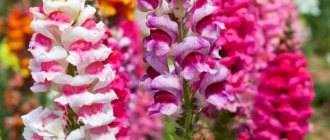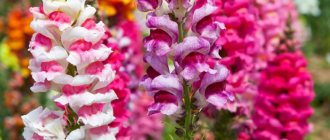Snowdrops
Snowdrops tolerate extremes of sub-zero and plus temperatures very well. It is better to plant snowdrops in well-lit places, but you should remember that snowdrops do not like places where the soil dries out very much in summer. Snowdrops look very beautiful in combination with shrubs and trees. It is better to plant snowdrops in combination with awl-shaped phlox, peonies, hostas and thyme. Snowdrops will look very beautiful on alpine slides.
Lilies
In order for lilies to bloom in the same year they were planted, you need to choose only healthy, mature bulbs for planting. If you plant children in the spring, they will bloom only in the next growing season.
In addition to bulbous flowers, all seed flowers are suitable for spring planting. These are all flowers that reproduce using seeds. These include chrysanthemums, asters, marigolds, petunias, carnations and bluebells.
Getting ready to land
You can grow healthy, strong plants only from intact seeds. Therefore, before planting, it is important to sort them out and treat them with a weak solution of potassium permanganate. Then they are dried and sown. When selecting planting material for bulbous plants, you should take into account: the larger the bulb, the stronger the flower will be. To protect vegetation from fungal diseases, the bulbs must be kept in the foundation solution for 30 minutes.
For planting, you need to use a light and nutritious substrate. It is obtained by mixing humus or compost with deciduous soil, peat and sand in equal parts. The earth can be disinfected by dousing it with boiling water or spilling it with a solution of manganese.
Bulbous plants do not tolerate excess moisture well, so the substrate for them should be medium-heavy and easily allow moisture to pass through. It is better to provide flower beds with a drainage layer. To do this, a hole is dug, at the bottom of which a layer of expanded clay or broken brick is laid. Prepared nutrient soil is poured on top.
Asters
Asters should be sown in early spring, then cover the soil with film until the threat of late frosts passes. It should be remembered that only annual species of asters are suitable for planting in spring. Perennials are propagated from the bush and planted in the fall.
Chrysanthemums
As soon as the spring frosts end, you can begin sowing chrysanthemums. In this case, the plants will take root well and gain a foothold in the soil, which will allow them to overwinter peacefully. It is best to plant chrysanthemums from cuttings at the end of May. Well-lit hills are best suited for planting chrysanthemums.
Related article: DIY gazebo made of metal pipe
Seedless method
Those who want to create a flower garden on their site with a minimum of effort and expense choose the seedless method. I threw the seed into the ground, watered it, it grew, and no problems with the seedlings.
However, only frost-resistant plants can be grown this way. And some crops do not tolerate transplants at all, so they are grown exclusively without seedlings. For example: cosmos, cornflowers, lupine, gypsophila, nasturtium, mignonette and others.
The exact timing of sowing in open ground primarily depends on the local climate and current weather.
The timing is also affected by the length of the growing season. For example, cold-resistant crops with a long growing season are sown early (approximately mid-April). And for heat-loving crops with a short growing season, late sowing is used (from about mid-May to early autumn).
Sow the seeds in soil prepared in advance. Grooves are made for small seeds, and nests are made for large ones. The depth of planting the seed should be equal to the sum of 2-3 of its diameters. And the distance between the seeds is at least 1 cm.
Then the crops are thinned several times. The first time - when the first true leaves appear, 5 cm are left between the seedlings. They are thinned out again 10 days after the first, but the distance is already greater - 10 cm between small plants, 30-40 cm between large ones.
Marigold
Marigolds are heat-loving flowers that do not tolerate frost at all. In addition, these flowers do not tolerate much moisture, although at the initial stage of germination it is better if the soil is sufficiently moist. To grow seedlings, seeds must be sown between March 15 and April 10.
Planting: How to Plant Flower Seeds in Open Ground
Preparatory work
Before you learn how to plant flower seeds, there is some preliminary work that needs to be done to get your garden and flower beds in order. See our Starting a Garden and How to Grow Flowers pages. From them you can learn all about creating the garden space where it needs to be to produce healthy, quality flowers.
Also be sure to give your plants enough room to grow. Pay attention to their height and width (see the Flowers section for this information). This will allow you to organize the space in the garden accordingly.
And finally, match your space with the lighting requirements of each flower. Most flowers need sun (at least 6 hours a day) or partial shade.
Assuming the space is ready, consider these steps to learn how to properly plant flower seeds (annual or perennial)...
- Plant at the appropriate time based on each flower's requirements: Perennial flower seeds are easier to sow in the fall for the reasons described above. If you want to plant them in the spring, you will need to first mix your seeds with vermiculite and evenly moisten the mixture until it is like a wrung out sponge. Place the mixture in a tightly sealed container and refrigerate for 2 ½ to 3 months. Do this ahead of time so the seeds should be ready when your planned planting date arrives.
- There are two things to consider when planting annual flower seeds: Crop rotation: Never plant the same type of flower in the same location every year. Ideally, wait at least three years before planting the same annual in the same location. (See CROP ROTATION for more on the importance of crop rotation).
- Frost resistance of plants: As described above, check the frost resistance level of each flower before planting to ensure timely planting in the ground.
See our How to Grow Flowers page for information on how to care for your flowers after you've thinned them out.
Petunias
Petunias are very unpretentious plants. They reproduce mainly by seeds. It is best to sow seeds for seedlings in March. Flowers will bloom 70-75 days after sowing. In order for the seeds to germinate, the following conditions must be met:
• Air temperature +22°…+24°С; • Humidity – 95-98%.
General tips for sowing annuals for seedlings
Growing annuals from seedlings is quite simple; even a novice gardener can do it. However, there are a number of rules that must be followed if you want to succeed:
- The soil should be light, loose, water- and breathable, and fertile. It must contain loosening elements: river sand, perlite or vermiculite.
- Before the procedure, disinfect the soil. The most effective methods of disinfection: calcination and steaming. To bake in the oven, you need to spread the substrate in a thin layer on a baking sheet, turn on the oven to 90 degrees and place the baking sheet for 30 minutes. To steam the soil, you should put it on a cloth, and then in a colander and keep it over the steam for 1.5 hours, do not forget to stir regularly. After disinfection, it is necessary to restore the beneficial microflora: spill with a solution of Fitosporin, Trichodermin or Alirin.
- To improve germination, you can treat annual seeds with a solution of a growth stimulant (for example, Zircon, Epin, Energen). To do this, prepare a solution and soak them according to the instructions.
- Pay careful attention to the drainage system, which implies the presence of holes and a drainage layer at the bottom of the container (for example, perlite, expanded clay, brick chips, layer thickness about 1.5-2 centimeters).
- After planting, you must create a mini-greenhouse - cover the container with a lid or film. Greenhouse conditions (high humidity and temperature) are necessary for seed germination.
- Do not forget to ventilate the greenhouse daily for 20-30 minutes to avoid the appearance of mold on the seedlings. After the emergence of seedlings, you need to remove the greenhouse gradually.
- Before emergence, the temperature should be maintained at about 22-23 degrees; after, the temperature should be between 20-21.
By the way! Almost all of the listed annuals can be planted in peat tablets. They are washers made of pressed peat. The main advantage is that you do not need to choose a substrate and container; the tablet already implies the function of these items. Before planting, you need to soak the washers in warm water for 0.5 hours.
Carnation
Carnation is also a flower that is best planted in spring. Planting for seedlings takes place in early March. Perennial varieties of carnations are propagated by cuttings or dividing the bush.
Aster
May spring flowers: photos and names
May already pleases with a wide variety of flower crops that begin to bloom in the first days of this month. We suggest focusing on the most popular garden crops, which will delight you with their beauty and sophistication.
Magic Lilies of the Valley
The very first spring flower, which is a symbol of romance and tender feelings, is the lily of the valley. To see how white bells bloom, you need to plant them in the autumn - in September and November. Since these bushes reproduce by dividing the rhizome, divide the plant and plant it in holes of the appropriate size.
Lily of the valley is considered an unpretentious crop; all that is required for its beauty is moderate soil moisture. The territory can be either in a sunny area or in the shade. Since lilies of the valley have a fairly strong root system, it should not be planted next to other crops. They can simply “squeeze” them out of the area.
Cute Daisies
Daisy or Pearl, as it is translated from Greek, is a unique culture that gets along well in any flowerbed. These specimens are annuals or perennials and can bloom 1 or 2 times a year.
The beginning of May is always accompanied by the opening of these buds. Winter is also not scary for them, but in the absence of snow it is better to cover the plant with spruce branches. The crop can be propagated by seed or cuttings.
Narcissist
This is a bulbous perennial representative that blooms from the first days of May. It can be either dwarf or tall. Its height is up to 5 centimeters, but there are also species that reach up to 50 centimeters in height.
Narcissus angustifolia
Daffodils grow best in a sunny place, but can also thrive in a shaded area. Landing takes place in September. The color of the petals is different - traditional white, yellow or bright orange.
Bee-loving Lungwort
Lungwort attracts bees with its aromas; the shade of the petals can be dark blue and pink at the same time. There is even a legend that the dark blue shade is a symbol of Adam, and the pink shade is a symbol of Eve.
Lungwort is often found in forests, forest edges or meadows, but it will find its place in flower beds.
Attractive fritillary flowers
Spring and spring flowers Hazel grouse are concepts that cannot be imagined without each other. The bulbous plant is planted with bulbs pre-treated with a solution of potassium permanganate.
Visually, such plants resemble the original palm tree, with flowers at the top. That is why hazel grouse are often called the tree of paradise. Care consists of proper watering and fertilization.
Bells
To plant bells, you need to choose a sufficiently lit place, slightly protected from direct sunlight. For seedlings, it is better to sow bells after the end of frost. Two weeks after germination, flowers can be planted in open ground. Bluebells do not need to be given a large space, as they can grow quite closely.
Flowers that reproduce by tubers are also planted in the spring. However, in order to plant them, the air temperature must be stable and high. Otherwise the tubers will freeze. These flowers include dahlias and some types of chrysanthemums.
I. Flowers that can be planted in early spring
In order for plants planted at the beginning of the season to bloom in the first half of summer, it is better to first sow them in containers or boxes. And when the snow melts and the earth warms up a little, the seedlings can be transplanted into flower beds. In March you can start breeding:
Kochia
It is sown in a greenhouse or container. Furrows are made in the ground, 1 cm deep. The seeds are placed at intervals of 20 cm. After a month, the kochia can be transferred to open ground.
Petunias
Before planting, the seed material is mixed with sand and not sprinkled with soil after sowing; it is sprayed from a spray gun. When the first leaves appear, the seedlings are moved to separate pots. In April, planting is done in the flower garden. The interval between holes is 25-30 cm. No more than 2-3 petunias are planted in balcony boxes with a volume of 8-10 liters.
Marigold
You can plant it directly into the flowerbed in April-May. They will bloom by the end of June, beginning of July. But in order for them to bloom earlier, they need to be sown at home in containers in early spring. Then marigolds will delight you with their flowering in May - early June. Sow them in furrows 1 cm deep at intervals of 2-3 cm from each other, sprinkle and water. The sprouts are planted in separate containers after the appearance of 2-3 carved leaves. In 2-3 weeks they will be ready to be planted in their permanent place.
Viola (pansy)
In March it is planted with seedlings. It is necessary to lay drainage at the bottom of the container for seedlings. The sprouts sprout twice: after the first leaves appear and after 5 weeks. at a distance of 6 cm. The viola is moved into open ground in mid-May, maintaining a distance of 10-15 cm.
Snapdragon
In warm regions, you can immediately plant it in a flower bed. But in a prolonged spring, it is better to grow seedlings in early March. The seeds are mixed with sand and sprinkled with soil after planting. They dive after 3 leaves appear. They are transplanted into the garden in May at intervals of 15-50 cm (depending on the variety).
Delphinium
They are also sown in March in furrows half a centimeter deep at a distance of 7 cm. After a month, the sprouts are divided. The flowers are moved to their permanent location in May.
Kobeya
It is advisable to germinate kobeya before planting. The seeds are then placed in the soil, flat side down. Kobeya is replanted with the appearance of the first foliage. They are transferred to the flowerbed at the beginning of summer, 75-90 cm apart.
Also in March, cineraria, ageratum, annual asters, balsam, verbena, gazania, heliotrope, sweet pea, morning glory, calceolaria, cleome, purslane, arctotis, gypsophila, etc. are bred.
And some more information in the video:
Boxes with seeds planted for seedlings are covered with film or glass and placed in a warm, dark place. Periodically, the film needs to be lifted to ventilate the seedlings. This will help prevent the occurrence of fungal diseases. When the shoots appear, you need to remove the film from the container and move it to the windowsills. It should be noted that in order to successfully grow seedlings at this time, it is necessary to provide additional lighting and optimal temperature (20 - 23⁰C).
Dahlias
Dahlias are very beautiful and bright flowers. They are widely used as border flowers, they are perfect for planting in a summer cottage. Dahlia tubers should be planted no earlier than mid-May in well-warmed soil. If the dahlia variety is tall, it is recommended to immediately install a support for it when planting.
Dividing and planting rhizomatous perennials
In spring, gardening stores, nurseries, and private traders offer a wide range of rhizomatous perennials - flowering and decorative foliage plants. Hostas , heucheras , astilbes , small-flowered chrysanthemums , phlox , clematis, roses, peonies, sedums, speedwells , delphiniums , bush hydrangeas , spirea , cinquefoil , honeysuckle and others. The species and varietal diversity is amazing! To guarantee survival, it is better to buy seedlings with a closed root system, which are sold in containers or pots.
It is advisable to choose a place in your garden a couple of weeks before the intended planting, taking into account the plant’s requirements for environmental factors and prepare the soil.
In the spring (until mid-May), the perennials that have grown in the dacha are divided, but only those that will bloom in August and autumn: asters, helenium, goldenrod, rudbeckia, phlox, chrysanthemums. To divide, the bush is dug up entirely and cut into pieces with a knife, each of which should have 3-5 buds and a piece of rhizome with a good root lobe. The cuttings are disinfected with ash, dried in the open air and planted. The renewal buds are buried 3-5 cm. The daughter bushes are watered and mulched.
The mother plant can be carefully divided without digging: the soil is raked off on one side, part of the visible rhizome is cut off and separated
Many rhizomatous crops are characterized by a process of particulation , in which the mother bush disintegrates due to the destruction of the main root. The curtain breaks up into daughter plants, which no longer bloom as luxuriantly as before. This happens in the 3-5th year of the perennial’s life. To prevent the natural process of degeneration, the bush is divided every 2-4 years or the planting is renewed with new plants grown from seeds. Nielweed , kareopsis , forget-me-not , delphinium , and lupine are subject to particulation .











